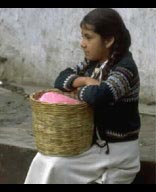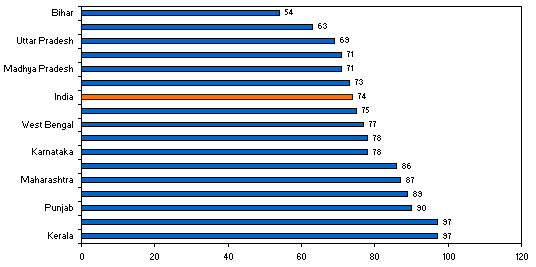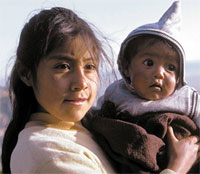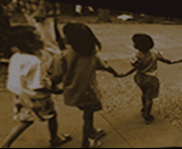GIRL CHILD IN INDIA
More than 50 years ago, a dream came true - A dream of Independent India. This dream gave birth to more dreams and hopes.
Indian Constitution asserts the principle of Equality - equality in Caste, Class, Religion and Gender.
Every girl has similar dreams as a boy does. The childhood does not differentiate between the Genders....WHY DO WE?
Do her dreams come true?
Inspite of the principle of Equality, a Girl Child in India is always considered as an economic burden. It is not enough to rely on the Government to lift these dark clouds and make their dreams come true. Each and every one of us can help the Girl Child to give her an equal opportunity. We all need to participate in this mission for our own nation, for our own society. The Girl Child needs your helping hand. |
As per the 1991 census, India has the lowest literacy rate in Asia. The gap between men and womens literacy ratio is a clear indicator of social discrimination.
In 1991 only 39% of Indian women could read and write. According to the census of India 2001, female literacy rates have gone up to 54%. Inspite of the innovative initiatives like the National Literacy Campaigns, and Special Education programmes for girls and women, the statistics today contradict many of our assumptions about the success of these programmes. |
|
Female Literacy in India (%) |
Kerala |
88 |
Gujarat |
59 |
Mizoram |
86 |
Karnataka |
57 |
Goa |
76 |
Assam |
56 |
Himachal Pradesh |
68 |
Haryana |
56 |
Maharashtra |
68 |
Chattisgarh |
52 |
Tamil Nadu |
65 |
Andra Pradesh |
51 |
Tripura |
65 |
Orissa |
51 |
Punjab |
64 |
Madhya Pradesh |
50 |
Nagaland |
62 |
Arunachal Pradesh |
44 |
Sikkim |
61 |
Rajasthan |
44 |
Meghalaya |
60 |
Uttar Pradesh |
43 |
Manipur |
60 |
Jammu and Kashmir |
42 |
West Bengal |
60 |
Jharkhand |
40 |
Uttaranchal |
60 |
Bihar |
34 |
|
|
|
The International Scorecard |
In most developed countries, almost the entire population can read and write. Even in many developing countries, the proportion of women who can read and write is similarly high. |
|
Female adult literacy rate (%) 1998 |
Thailand |
94 |
Viet Nam |
91 |
Sri Lanka |
87 |
Malaysia |
83 |
India |
54 |
Indonesia |
81 |
China |
76 |
Congo |
73 |
Zambia |
70 |
Tanzania |
66 |
Madagascar |
59 |
Rwanda |
59 |
|
|
|
Girls 6 - 14 years attending school: 1998 - 1999 |

% of girls 6 - 14 attending school
|
(Source: International Institute for Population Sciences 2000,
National Family Health Survey - 2, 1998-99) |
|
Workforce Participation Rates of Children, 1991 |
An accurate idea of the work burden of girls is not conveyed by official statistics. According to the last Census, only a very small percentage of girls of school - going age were recorded as workers. The highest number was in Andhra Pradesh, where every tenth girl in the age group of five to fourteen years was a member of the paid work force. |
State |
Total Workers |
% of girls in 5 - 14 age group recorded as workers |
Andhra Pradesh |
5.53 |
10.54 |
Bihar |
3.35 |
2.93 |
Karnataka |
5.61 |
8.71 |
Madhya Pradesh |
4.79 |
8.56 |
Rajasthan |
4.57 |
7.88 |
Uttar Pradesh |
3.14 |
2.46 |
West Bengal |
3.23 |
2.68 |
|
|
|
Domestic Child Labour and Girl Child Labour in India |
Child labour is a significant problem in India. There is a higher rate of child participation in work compared to other developing countries. Millions of children start working at the age of four. The major cause of Child Labour in India is poverty. Lack of social awareness and access to education are amongst the others.
Although the Constitution of India assures prevention of Child Labour, the geographical expanse and population make it very difficult to keep a track of all the households engaging children into domestic work or agricultural work either for their families or for wages.
Indian women are socially constrained to work on domestic as well as earning front. The problem is even more acute in the rural India. 
The Girl Child in India is a victim of this culture and is burdened with the family responsibilities at a very early age. |
|
Gender Gap in Literacy (in %) |
|
1991 Census |
2001 Census |
India |
25 |
22 |
Andhra Pradesh |
22 |
20 |
Assam |
19 |
16 |
Bihar |
29 |
27 |
Chattisgarh |
31 |
25 |
Goa |
17 |
13 |
Gujarat |
24 |
22 |
Haryana |
29 |
23 |
Himachal Pradesh |
23 |
18 |
Jammu & Kashmir |
25 |
24 |
Jharkhand |
30 |
29 |
Karnataka |
23 |
19 |
Kerala |
7 |
6 |
Madhya Pradesh |
29 |
27 |
Maharashtra |
24 |
19 |
Manipur |
24 |
18 |
Meghalaya |
8 |
6 |
Mizoram |
7 |
5 |
Nagaland |
13 |
10 |
Orissa |
28 |
25 |
Punjab |
15 |
12 |
Rajasthan |
35 |
32 |
Sikkim |
19 |
15 |
Tamil Nadu |
22 |
18 |
Tripura |
21 |
16 |
Uttar Pradesh |
30 |
27 |
Uttaranchal |
31 |
24 |
West Bengal |
21 |
17 |
|
|
|
An effort to bridge the literacy gap. |

|
There is an alarming gap in the literacy leves between men and women in India.
The girls get tied down unquestioningly to their "Traditional" roles of managing the household responsibilities.
Many women's groups are of a view that provision of bare minimum support services like, childcare centres, domestic and cooking fuel supplies and water at the village level would be of great help to women.
Promoting cottage industry is another positive way of bridging this literacy gap. Providing domestic and remote marketing support will make the women in rural areas financially independent leading to a substantial increase in women's literacy ratio. |
|
Propagation of school network in India |
There has been a steady increase in the number of rural schools in India over a period of 50 years of Independence. According to the records, 95% of the rural population of India has availability of Primary schools. However the surveys denote extremely poor condition of school buildings, inadequate teaching facilities, insufficient books, lack of playgrounds, etc. at most of the places. The condition of schools is illustrated through the example below. |
State of schools in North India |
The Public Report on Basic Education (PROBE) reports the results of 1996
survey of 1221 primary schools in 188 randomly selected villages in Bihar,
Madhya Pradesh, Rajasthan and Uttar Pradesh. |

|
44% of schools did not have playground. |

|
54% of schools did not have drinking water facility. |

|
55% of schools did not have teaching kits. |

|
61% of schools did not have toys. |

|
72% of schools did not have library. |

|
84% of schools did not have toilets. |

|
12% of schools were single teacher schools, where a single teacher handled all the five classes together with over 100 pupils. |
|
|
We all need to be sensitive towards these social issues. Especially the Girl Child issue should be addressed with more empathy and a humanistic approach. |
|